![]()
Hedione
Methyl dihydrojasmonate
The perfume ingredient that is said to attract women
![]()
Simon Cotton
University of Birmingham
![]()
Molecule of the Month February 2025
Also available: HTML version.
![]()
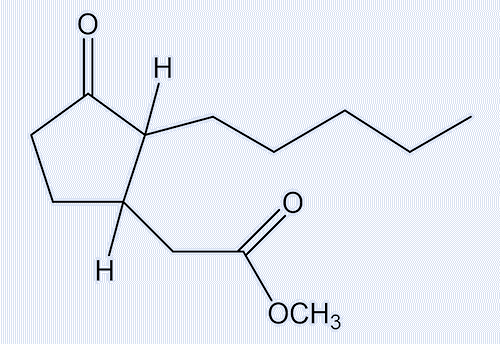
|
HedioneMethyl dihydrojasmonateThe perfume ingredient that is said to attract women
Simon Cotton
Molecule of the Month February 2025
|  |
Is this molecule something to do with Hedy Lamarr?You must be old to have heard of her! Hedy Lamarr (1914-2000) – whose real name was Hedwig Eva Maria Kiesler - was a beautiful and intelligent actress who made famous films before and after World War II, and who also was the co-inventor of Spread Spectrum Technology, an unbreakable code. This involves sending a signal with a variable frequency that makes it difficult to intercept, a variation following a complex formula. Of course, the intended receiver must also know the exact variation, so that it is synchronised. Lamarr and the composer George Antheil originally designed the system for use in radio-controlled torpedoes in 1942. But no, it’s nothing to do with her. Hedione gets its name, however, from the Greek hedone (ηδονή), which means pleasure (as in ‘hedonist’), a name it was given by its inventors at the perfume company Firmenich. But it still has film-star connections, just be patient. |
 Hedy Lamarr [Photo: MGM/Clarence Bull, Public domain, via Wikimedia Commons] |
Yes, it has a similar structure to methyl jasmonate, one of the key odorants of jasmine (MOTM for September 2001), and hedione smells of jasmine, too. It was ‘discovered’ by the perfume chemist Edouard Demole in the course of doing his Ph.D., in 1959; it was patented (and published) within less than five years.
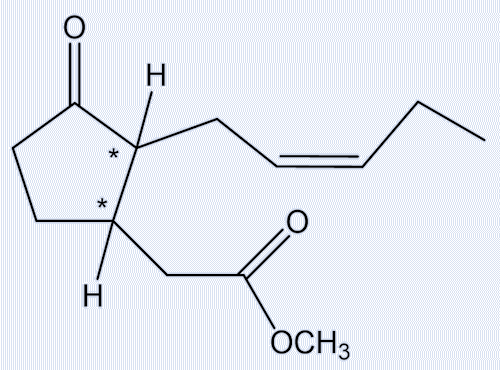 |
| Methyl jasmonate |
To be precise, only some methyl jasmonate (MeJA) molecules smell of jasmine. MeJA has two chiral carbon atoms (*) in the diagram above, which means that it has four isomers. Only one of these has a strong jasmine smell, and two are completely odourless.
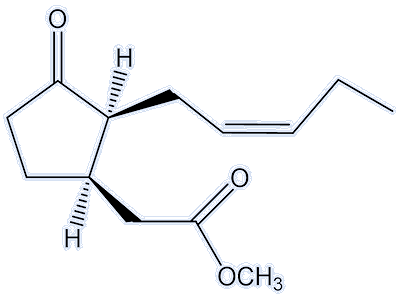 |
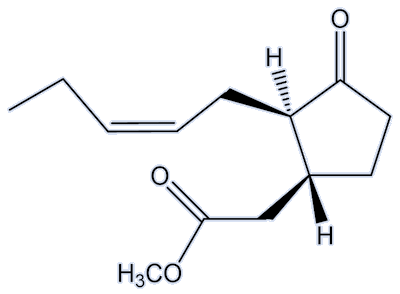 |
| (1R,2S)-(+)-Z-epimethyljasmonate strong jasmine odour, detection threshold 3 ppb. |
(1S,2R)-(-)-Z-epimethyljasmonate odourless. |
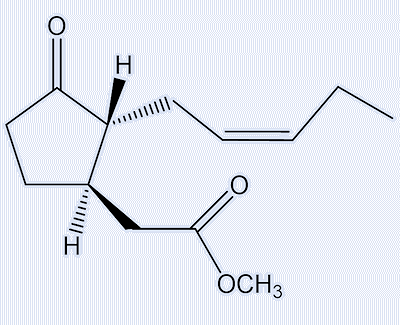 |
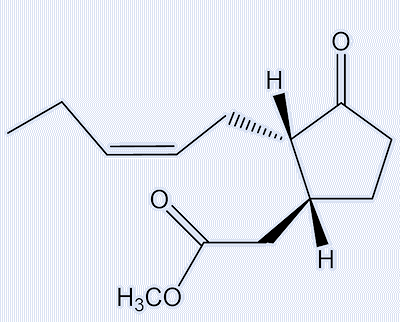 |
| (1R,2R)-(-)-Z-methyljasmonate weak odour, detection threshold 70 ppb |
(1S,2S)-(+)-Z-methyljasmonate odourless. |
Methyl dihydrojasmonate, again, exists as four isomers; two pairs of enantiomers (non-superimposable mirror-image isomers) related by epimerisation at one of the chiral carbon atoms leading to the diastereoisomers (stereoisomers that are not mirror-images). The four isomers all have distinct smells, though differing a lot in their recognition threshold (not the same as the detection threshold used for methyl jasmonate).
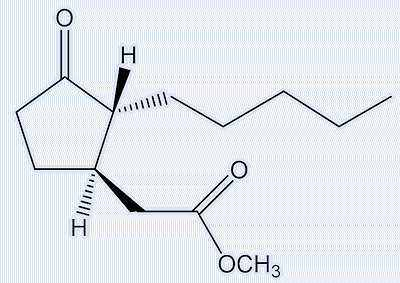 |
 |
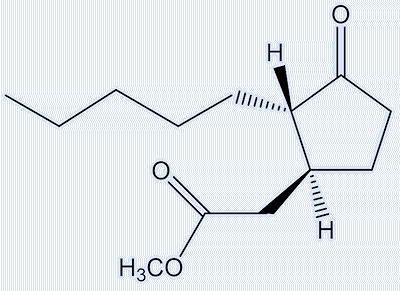 |
| (1R,2R)-(-)-Z-methyldihydrojasmonate detection threshold 240 ppb. |
(1S,2S)-(+)-Z-methyldihydrojasmonate detection threshold 15360 ppb. |
|
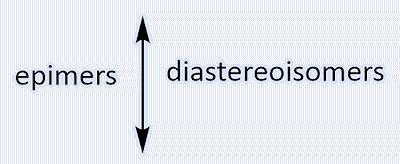 |
 |
|
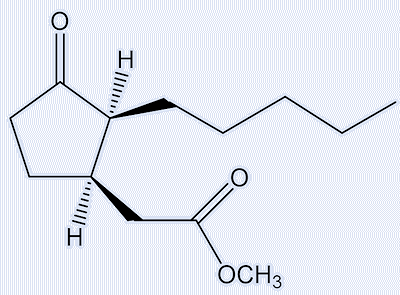 |
 |
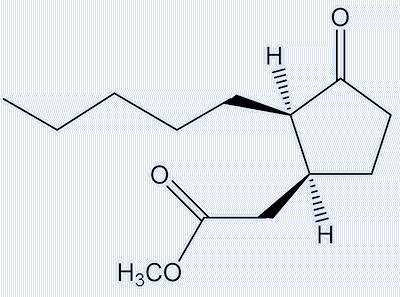 |
| (1R,2S)-(+)-Z-methyldihydrojasmonate detection threshold 15 ppb. |
(1S,2R)-(-)-Z-methyldihydrojasmonate detection threshold 12500 ppb. |
And in 1966, hedione was used by the perfumer Edmond Roudnitska, working for Dior, to make the perfume Eau Sauvage.
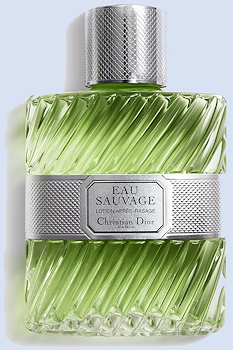 So people started splashing methyl dihydrojasmonate all over them?
So people started splashing methyl dihydrojasmonate all over them?Yes, and a lot of other chemicals too.
Ever since 1889, when Coty introduced its pioneering perfume Jicky, the leading perfumers have used ‘structured’ perfumes with a ‘top note’, a ‘middle note’ and a ‘bottom note’. The ‘top note’ in Jicky, the part that gave the immediate impact, was composed of lemon, bergamot and mandarin, with a citrus smell. The ‘middle’ floral note’ used rose and jasmin, together with ’woody’ vetiver, orris and patchouli; and a ‘bottom note’ – the part that gives a long-term smell when all other molecules have evaporated – of molecules like coumarin (a recently discovered synthetic molecule), vanillin (MOTM February 2008) and amber, among others. So perfumes use a mixture of chemicals, not just one.
Eau Sauvage featured bergamot (lavender-like), lemon and basil in the top note; jasmin (methyl dihydrojasmonate) and patchouli (cedar smell) in the middle note; and oak moss (earthy smell with a hint of musk) in the base note.
The leading perfume writer Luca Turin gives Eau Sauvage a five-star rating (“I always forget how good this darned thing is”).
As Christian Chapuis of Firmenich has pointed out, although by itself hedione did not have that strong a smell, it exhibited a synergistic effect, viz: -‘Hedione rendered perfumes round, floral and diffusive.’ It gave some perfumes ‘a greater faculty to fill a room with fragrance’, compared to hedione-less perfumes.
As we’ve seen, hedione was first used in 1966 by Christian Dior to power a pioneering male eau de toilette, Eau Sauvage, and it has since found its way into many others. Hedione was very expensive at first, which partly explains the tiny amount of it in Eau Sauvage (2.5%). With economies of scale, costs came down, and it came to be used in greater amounts in perfumes - Diorella (Dior, 1972, 8%); Chanel N°19 (Chanel, 1971, 12.6%); First (Van Cleef & Arpels, 1976, 18%); Cristalle (Chanel, 1993, 26%); and Odeur 53 (Comme des Garçons, 1998, 65%) - as well as in other bodily care products.
Steve McQueen used Eau Sauvage aftershave, though women insisted that his natural gifts were quite sufficient on their own. So it hits the spot?Yes, and possibly in unexpected ways. Back in 2015, German researchers at the University of Bochum reported that hedione activates the VN1R1 receptor, a possible pheromone receptor found in the human nose. They went on to discover that smelling hedione causes greater responses from parts of the limbic system than did natural perfume molecules, and even activated a particular region of the hypothalamus in the female brain more than it did in mens’ brains. No wonder some women went for Steve McQueen. Tests on women have shown hedione to increase response to certain stresses, though it does not affect female assessment of men’s attractiveness. Clearly, there are things still to be understood. |
 Steve McQueen in The Great Escape |
![]()
![]()
![]() Back to Molecule of the Month page. [DOI:10.6084/m9.figshare.24718239]
Back to Molecule of the Month page. [DOI:10.6084/m9.figshare.24718239]